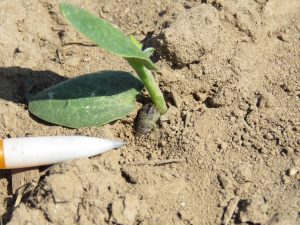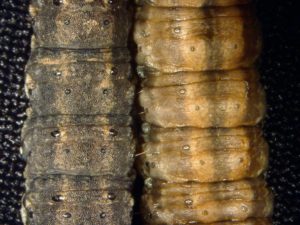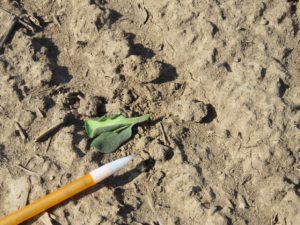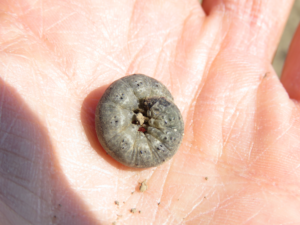Info about the culprit insect: Cutworms are the larval (caterpillar) stage of moths in the family Noctuidae, which typically fly at night. Although the adult moths are not damaging, the voracious larvae can be! The caterpillars typically hide during the day and emerge at night, curling around young, tender plants to feed.

Figure 1. A cutworm caterpillar caught in the act of feeding on a young seedling during the day. Photo: L. Maynard, Purdue University.
How many kinds of cutworms are there?
There are several species of cutworms, but you are most likely to encounter one of four species of cutworm in Indiana: either the dingy, variegated, or clay backed cutworms, which overwinter as partially grown larvae, or the black cutworm, which does not overwinter in the Midwest, but migrates back each year. The black and clay backed cutworms are leaf feeders and plant (stem) cutters, while the dingy and variegated cutworms are mainly leaf feeders that rarely cut plants at or below the ground level.
What crops do cutworms attack?
Cutworms are generalist feeders that readily eat a wide range of vegetable and fruit crops, as well as common weeds in the garden. For example, variegated cutworms will feed on beets, cabbage, lettuce, corn, potato, tomato, and weeds like jimsonweed, shepherd’s purse, and docks and sorrels. Let’s just say if it’s a veggie in your garden, cutworms will eat it if they are hungry. Species like the black cutworm exhibit the characteristic snipping of young plants (seedlings and new transplants) right at the base of the stem where it emerges from the soil, leaving behind seedlings that appear to have been ‘cut down’ (Figure 2), thus the name ‘cutworm.’
In addition to early season stem cutting and defoliation, cutworms can also cause damage later in the season. For example, we have seen cutworm feeding on ripening tomato fruit in high tunnels – definitely an unpleasant discovery!
How do you identify cutworms?
This can be challenging, as there are several different species that look similar, so magnification is required, as well as some familiarity with caterpillar morphology. Perhaps the easiest way to confirm an ID is sending a clear, focused image of the top of the caterpillar (dorsal side) to us at the Purdue Plant and Pest Diagnostic Laboratory. However, if you’re willing to get up close and personal, use a magnifying glass or hand lens with at least 10X magnification and carefully examine the texture of the caterpillar’s body surface. If it appears bumpy, it is most likely a black cutworm. In contrast, the other cutworm species have a smooth body surface (Figure 3). Ultimately, cutworms are all managed similarly regardless of the species, so the most important factor to determine is whether or not the culprit is indeed a cutworm.

Figure 3. ‘Bumpy’ versus ‘smooth’ skin texture of the black (left) and dingy (right) cutworm at ~10X magnification. Photo by John Obermeyer.
Because cutworm adults and larvae are active at night, scouting during the daylight hours can be a bit of a challenge. Fortunately, pheromone traps are available to monitor the activity of the black cutworm as it migrates back to Indiana from the south. You can find trap catches reported weekly in the Purdue Pest & Crop newsletter found here. The number is impressive recently. The article Some Cutworms Out and About, Still Too Early for Black Cutworm published on Pest & Crop newsletter provides more information about cutworms and the black cutworm trapping efforts.
If you suspect cutworm damage in your crop, dig ~5 cm into the soil around the base of damaged plants to try to unearth the offender. Cutworms will curl up in a distinctive ‘c’ shape when disturbed or pulled from the soil (Figure 4). This is the easiest way to capture and identify them during the daytime because the caterpillars take refuge under the soil surface or plastic mulch until darkness falls.
Figure 4. Cutworm caterpillar displaying the distinctive ‘c’ shape after being disturbed and removed from the soil. Photo: Liz Maynard.
- Mow or implement bare-ground borders around your crop, as removal of plant debris makes the site less attractive.
- Do not plant cover crops or use green manure in areas where cutworms tend to be a problem; instead use compost amendments to boost organic matter. The green material may be a suitable food source that is attractive to the pest.
- Avoid organic mulches between the rows as this provides shelter for the caterpillars.
- Water early in the day so the soil surface can dry out prior to the evening when cutworms are active. They do not like to crawl through dry soil.
For commercial growers who experience cutworm damage, monitoring is crucial. Scout in the evenings if possible, when cutworms increase their activity. Search under the plastic mulch and in the top soil around the base of suspected injured plants. If using insecticides, apply them as close to the evening as possible to target the activity time of the caterpillars, and remember: insecticides are more efficacious against the younger, smaller cutworms. Active ingredients labeled to control cutworms in vegetables include β-cyfluthrin (ex. Baythroid®XL), Bt (ex. DiPel®DF or Javelin® WG), Carbaryl as a bait, Malathion, or Permethrin. Many of these insecticides have broad-spectrum action against insects and can therefore harm beneficial insects residing in and around your crops. Please use insecticides judiciously and with caution, always following the product label specifications. Here’s to hoping your vegetable crops will be cutworm free!

